Impact of Directly Assimilating Radar Reflectivity Using a Reflectivity Operator Based on a Double-Moment Microphysics Scheme on the Analysis and Forecast of Typhoon Lekima (1909)
Abstract
1. Introduction
2. Observation Operators and Data Assimilation Procedure
2.1. Observation Operators
2.2. The EnKF Data Assimilation Procedure
3. Overview of Typhoon Lekima Case and Experimental Design
| Experiment | Microphysics Scheme for Model Integration | Microphysics Scheme for Observation Operator | Analysis Variables Updated by EnKF |
|---|---|---|---|
| TM | Thompson | Thompson | , , , , , , , , , , , |
| LIN | As in TM | Lin | As in TM |
| LIN_TM | As in TM | Same as LIN for whole DA cycles, but the background and analysis reflectivity shown in Figure 2, Figure 3 and Figure 4 is calculated by Thompson operator. | As in TM |
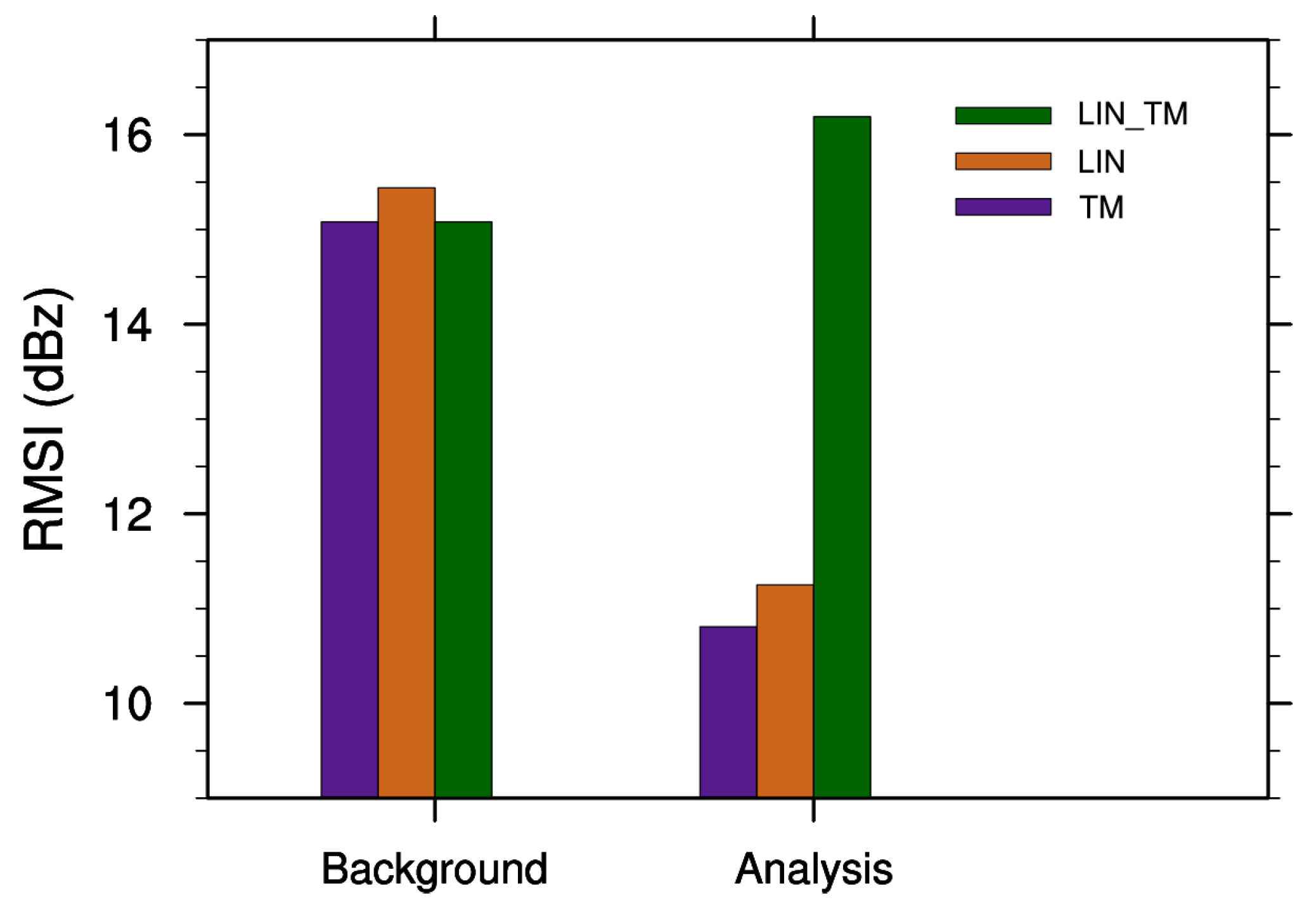
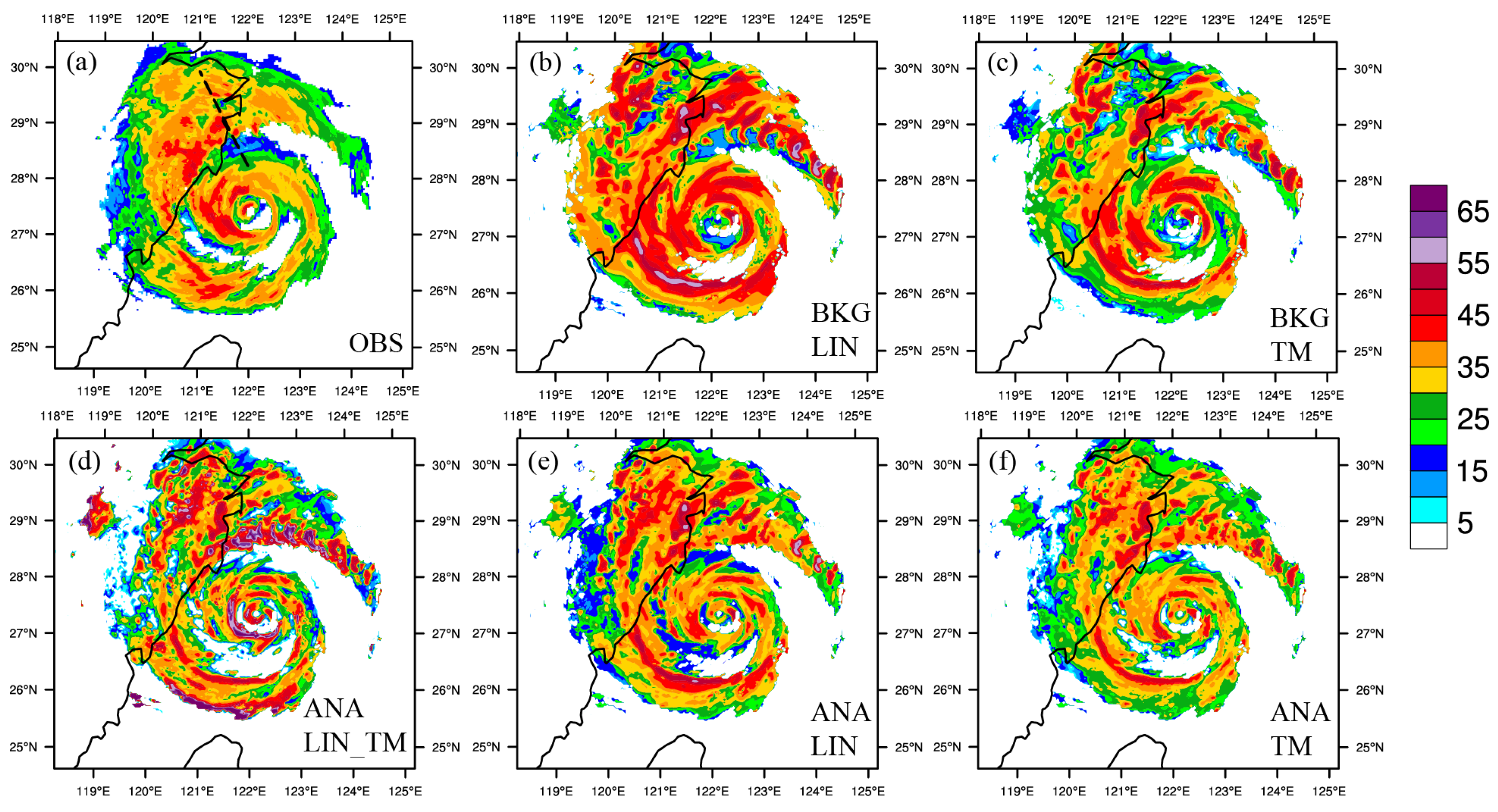


4. Results
4.1. Results of First-Time Analyses
4.2. Results of 1H-CYCLED Analyses
4.3. Results of 12-h Forecasts
5. Conclusions and Discussion
Author Contributions
Funding
Data Availability Statement
Conflicts of Interest
References
- Ulbrich, C.W. Natural variations in the analytical form ofthe raindrop size distribution. J. Clim. Appl. Meteorol. 1983, 22, 1204–1215. [Google Scholar] [CrossRef]
- Milbrandt, J.A.; Yau, M.K. A multimoment bulk microphysics parameterization. Part I: Analysis of the role of thespectral shape parameter. J. Atmos. Sci. 2005, 62, 3051–3064. [Google Scholar] [CrossRef]
- Lin, Y.L.; Farley, R.D.; Orville, H.D.; Farley, H.D. Orville Bulk parameterization of the snow field in a cloud model. J. Clim. Appl. Meteorol. 1983, 22, 1065–1092. [Google Scholar] [CrossRef]
- Kessler, E. On the continuity and distribution of water substance in atmospheric circulations. Atmos. Res. 1995, 38, 109–145. [Google Scholar] [CrossRef]
- Ferrier, B.S. A double-moment multiple-phase four-classbulk ice scheme. Part I: Description. J. Atmos. Sci. 1994, 51, 249–280. [Google Scholar] [CrossRef]
- Thompson, G.; Rasmussen, R.M.; Manning, K. Explicit forecasts of winter precipitation using an improved bulkmicrophysics scheme. Part I: Description and sensitivity analysis. Mon. Weather Rev. 2004, 132, 519–542. [Google Scholar] [CrossRef]
- Milbrandt, J.A.; Yau, M.K. A multimoment bulk microphysics parameterization. Part II: A proposed three-moment closure andscheme Description. J. Atmos. Sci. 2005, 62, 3065–3081. [Google Scholar] [CrossRef]
- Dawson, D.T.; Xue, M.; Milbrandt, J.A.; Yau, M.K. Comparison of evaporation and cold pool development between single-moment and multimoment bulk microphysics schemes in idealized simulations of tornadic thunderstorms. Mon. Weather Rev. 2010, 138, 1152–1171. [Google Scholar] [CrossRef]
- Thompson, G.; Field, P.R.; Rasmussen, R.M.; Hall, W.D. Explicit Forecasts of Winter Precipitation Using an Improved Bulk Microphysics Scheme. Part II: Implementation of a New Snow Parameterization. Mon. Weather Rev. 2008, 136, 5095–5115. [Google Scholar] [CrossRef]
- Benjamin, S.G.; Weygandt, S.S.; Brown, J.M.; Hu, M.; Alexander, C.R.; Smirnova, T.G.; Olson, J.B.; James, E.P.; Dowell, D.C.; Grell, G.A.; et al. A North American hourlyassimilation and model forecast cycle: The Rapid Refresh. Mon. Weather Rev. 2016, 144, 1669–1694. [Google Scholar] [CrossRef]
- Alexander, C.; Dowell, D.C.; Hu, M.; Olson, J.; Smirnova, T.; Ladwig, T.; Weygandt, S.; Kenyon, J.S.; James, E.; Lin, H.; et al. Rapid Refresh (RAP) andHigh Resolution Rapid Refresh (HRRR) model development. In Proceedings of the 30th Conference on Weather Analysis and Forecasting (WAF)/26th Conference on Numerical Weather Prediction (NWP), Boston, MA, USA, 15 January 2020. [Google Scholar]
- Jankov, I.; Beck, J.; Wolff, J.; Harrold, M.; Olson, J.B.; Smirnova, T.; Alexander, C.; Berner, J. Stochastically perturbedparameterizations in an HRRR-based ensemble. Mon. Weather Rev. 2019, 147, 153–173. [Google Scholar] [CrossRef]
- Smith, T.L.; Benjamin, S.G.; Brown, J.M.; Weygandt, S.; Smirnova, T.; Schwartz, B. Convection forecastsfrom the hourly updated, 3-km High Resolution RapidRefresh (HRRR) model. In Proceedings of the 24th Conference on Severe Local Storms, Savannah, GA, USA, 27 October 2008. [Google Scholar]
- Li, H.; Luo, J.; Xu, M. Ensemble data assimilation and prediction of typhoon and associated hazards using TEDAPS: Evaluation for 2015–2018 seasons. Front. Earth Sci. 2019, 13, 733–743. [Google Scholar] [CrossRef]
- Sun, J.; Crook, N.A. Dynamical and microphysicalretrieval from Doppler radar observations using a cloud modeland its adjoint. Part I: Model development and simulated dataexperiments. J. Atmos. Sci. 1997, 54, 1642–1661. [Google Scholar] [CrossRef]
- Hu, M.; Xue, M.; Brewster, K. 3DVAR and cloud analysis with WSR-88D level-II data for the prediction of the FortWorth, Texas, tornadic thunderstorms. Part I: Cloud analysisand its impact. Mon. Weather Rev. 2006, 134, 675–698. [Google Scholar] [CrossRef]
- Gao, J.; Stensrud, D.J. Assimilation of reflectivity datain a convective-scale, cycled 3DVAR framework with hydrometeor classification. J. Atmos. Sci. 2012, 69, 1054–1065. [Google Scholar] [CrossRef]
- Carley, J. Hybrid Ensemble-3DVar Radar Data Assimilationfor the Short-Term Prediction of Convective Storms. Ph.D. Thesis, Department of Earth, Atmospheric, and PlanetarySciences, Purdue University, West Lafayette, IN, USA, 2012; p. 205. [Google Scholar]
- Yussouf, N.; Mansell, E.R.; Wicker, L.J.; Wheatley, D.M.; Stensrud, D.J. The ensemble Kalman filter analyses and forecasts of the 8 May 2003 Oklahoma City tornadic supercell storm using single- and double-moment microphysics schemes. Mon. Weather Rev. 2013, 141, 3388–3412. [Google Scholar] [CrossRef]
- Duda, J.D.; Wang, X.; Wang, Y.; Carley, J.R. Comparing the assimilation of radar reflectivity using the direct GSIbased Ensemble–Variational (EnVar) and indirect cloudanalysis methods in convection-allowing forecasts over thecontinental United States. Mon. Weather Rev. 2019, 147, 1655–1678. [Google Scholar] [CrossRef]
- Kong, R.; Xue, M.; Liu, C. Development of a hybrid En3DVar data assimilation system and comparisons with 3DVar and EnKF for radar data assimilation with observing system simulation experiments. Mon. Weather Rev. 2018, 146, 175–198. [Google Scholar] [CrossRef]
- Liu, C.; Xue, M.; Kong, R. Direct variational assimilation of radar eflectivity and radial velocity data: Issues withnonlinear reflectivity operator and solutions. Mon. Weather Rev. 2020, 148, 1483–1502. [Google Scholar] [CrossRef]
- Liu, C.; Li, H.; Xue, M.; Jung, Y.; Park, J.; Chen, L.; Kong, R.; Tong, C.-C. Use of a Reflectivity Operator Based on Double-Moment Thompson Microphysics for Direct Assimilation of Radar Reflectivity in GSI-Based Hybrid En3DVar. Mon. Weather Rev. 2022, 150, 907–926. [Google Scholar] [CrossRef]
- Wang, Y.; Wang, X. Direct assimilation of radar reflectivity without tangent linear and adjoint of the nonlinear observation operator in the GSI-based EnVar system: Methodology and experiment with the 8 May 2003 Oklahoma City tornadic supercell. Mon. Weather Rev. 2017, 145, 1447–1471. [Google Scholar] [CrossRef]
- Smith, P.L.; Myers, C.G., Jr.; Orville, H.D. Radar reflectivity factor calculations in numerical cloud models using bulk parameterization of precipitation processes. J. Appl. Meteor. 1975, 14, 1156–1165. [Google Scholar] [CrossRef]
- Tong, C.C.; Jung, Y.; Xue, M.; Liu, C. Direct assimilation of radar data with ensemble Kalman filter and hybridensemble-variational method in the National Weather Service operational data assimilation system GSI for the standalone regional FV3 model at a convection-allowing resolution. Geophy. Res. Lett. 2020, 47, e2020GL090179. [Google Scholar] [CrossRef]
- Jung, Y.; Zhang, G.; Xue, M. Assimilation of simulated polarimetric radar data for a convective storm using ensemble Kalman fifilter. Part I: Observation operators for reflflectivity and polarimetric variables. Mon. Weather Rev. 2008, 136, 2228–2245. [Google Scholar] [CrossRef]
- Luo, J.; Li, H.; Xue, M.; Zhu, Y. Direct Assimilation of Radar Reflectivity Data Using Ensemble Kalman Filter Based on a Two-Moment Microphysics Scheme for the Analysis and Forecast of Typhoon Lekima (2019). Remote Sens. 2022, 14, 3987. [Google Scholar] [CrossRef]
- Xue, M.; Jung, Y.; Zhang, G. Zhang. State estimation of convective storms with a two-moment microphysics scheme and an ensemble Kalman filter: Experiments with simulated radar data. Q. J. R. Meteorol. Soc. 2010, 136, 685–700. [Google Scholar] [CrossRef]
- Waterman, P.C. Scattering by dielectric obstables. Alta Freq. 1969, 38, 348–352. [Google Scholar]
- Vivekanandan, J.; Adams, W.M.; Bringi, V.N. Bringi Rigorous approach to polarimetric radar modeling of hydrometeor orientation distributions. J. Appl. Meteorol. 1991, 30, 1053–1063. [Google Scholar] [CrossRef]
- Kleist, D.T.; Parrish, D.F.; Derber, J.C.; Treadon, R.; Wu, W.-S.; Lord, S. Introduction of the GSI into the NCEP global data assimilation system. Weather Forecast. 2009, 24, 1691–1705. [Google Scholar] [CrossRef]
- Whitaker, J.S.; Hamill, T.M. Hamill Ensemble data assimilation without perturbed observations. Mon. Weather Rev. 2002, 130, 1913–1924. [Google Scholar] [CrossRef]
- Huang, H.; Li, Q.; Zhao, K.; Dai, H.; Ming, J.; Fan, X.; Xu, Y.; Duan, Y.; Lee, W.; Zheng, F. Microphysical characteristics of the phase-locking VRW-induced asymmetric convection in the outer eyewall of Super Typhoon Lekima (2019). Geophy. Res. Lett. 2021, 49, e2021GL096869. [Google Scholar] [CrossRef]
- Wang, Z.; Luo, J.; Li, H.; Zhu, Y. Direct assimilation of simulated radar reflectivity for typhoon In-fa using EnKF: Issue with state variables updating. Trop. Cyclone Res. Rev. 2024, 13, 24–32. [Google Scholar] [CrossRef]
- Skamarock, W.C.; Klemp, J.B.; Dudhia, J.; Gill, D.O.; Barker, D.M.; Duda, M.G.; Huang, X.Y.; Wang, W.; Powers, J.G. A Description of the Advanced Research WRF Version 2; NCAR Technical Note NCAR/TN-4681STR; University Corporation for Atmospheric Research: Boulder, CO, USA, 2005; p. 88. [Google Scholar]
- Hong, S.-Y.; Noh, Y.; Dudhia, J. A new vertical diffusion package with an explicit treatment of entrainment processes. Mon. Weather Rev. 2006, 134, 2318–2341. [Google Scholar] [CrossRef]
- Chen, F.; Dudhia, J. Coupling an advanced land surface-hydrology model with the Penn State–NCAR MM5modeling system. Part I: Model implementation and sensitivity. Mon. Weather Rev. 2001, 129, 569–585. [Google Scholar] [CrossRef]
- Iacono, M.J.; Delamere, J.S.; Mlawer, E.J.; Shephard, M.W.; Clough, S.A.; Collins, W.D. Radiative forcing bylong-lived greenhouse gases: Calculations with the AER radiative transfer models. J. Geophys. Res. 2008, 113, D13103. [Google Scholar] [CrossRef]
- Barker, D.M.; Huang, W.; Guo, Y.-R.; Bourgeois, A.J.; Xiao, Q.N. A Three-Dimensional Variational Data Assimilation System for MM5: Implementation and Initial Results. Mon. Weather Rev. 2004, 132, 897–914. [Google Scholar] [CrossRef]
- Helmus, J.J.; Collis, S.M. The Python ARM Radar Toolkit (Py-ART), a Library for Working with Weather Radar Data in the Python Programming Language. J. Open Source Softw. 2016, 4, e25. [Google Scholar] [CrossRef]
- Gaspari, G.; Cohn, S.E. Construction of correlation functions in two and three dimensions. Q. J. R. Meteorol. Soc. 1999, 125, 723–757. [Google Scholar] [CrossRef]
- Whitaker, J.S.; Hamill, T.M. Hamill. Evaluating Methods to Account for System Errors in Ensemble Data Assimilation. Mon. Weather Rev. 2012, 463, 3078–3089. [Google Scholar] [CrossRef]
- Didlake, A.C.; Kumjian, M.R. Examining Polarimetric Radar Observations of Bulk Microphysical Structures and Their Relation to Vortex Kinematics in Hurricane Arthur. Mon. Weather Rev. 2017, 145, 4521–4541. [Google Scholar] [CrossRef]
- Wu, D.; Zhang, F.; Chen, X.; Ryzhkov, A.; Zhao, K.; Kumjian, M.R.; Chen, X.; Chan, P.-W. Evaluation of Microphysics Schemes in Tropical Cyclones Using Polarimetric Radar Observations: Convective Precipitation in an Outer Rainband. Mon. Weather Rev. 2021, 149, 1055–1068. [Google Scholar] [CrossRef]
- Dai, H.; Zhao, K.; Li, Q.; Lee, W.-C.; Ming, J.; Zhou, A.; Fan, X.; Yang, Z.; Zheng, F.; Duan, Y. Quasi-periodic intensification of convective asymmetries in the outer eyewall of Typhoon Lekima (2019). Geophy. Res. Lett. 2021, 48, e2020GL091633. [Google Scholar] [CrossRef]
- Kumjian, M.R.; Ryzhkov, A.V. Polarimetric signatures in supercell thunderstorms. J. Appl. Meteorol. Climatol. 2008, 47, 1940–1961. [Google Scholar] [CrossRef]
- Jung, Y.; Xue, M.; Zhang, G. Simulations of polarimetric radar signatures of a supercell storm using a two-moment bulk microphysics scheme. J. Appl. Meteorol. Climatol. 2010, 49, 146–163. [Google Scholar] [CrossRef]



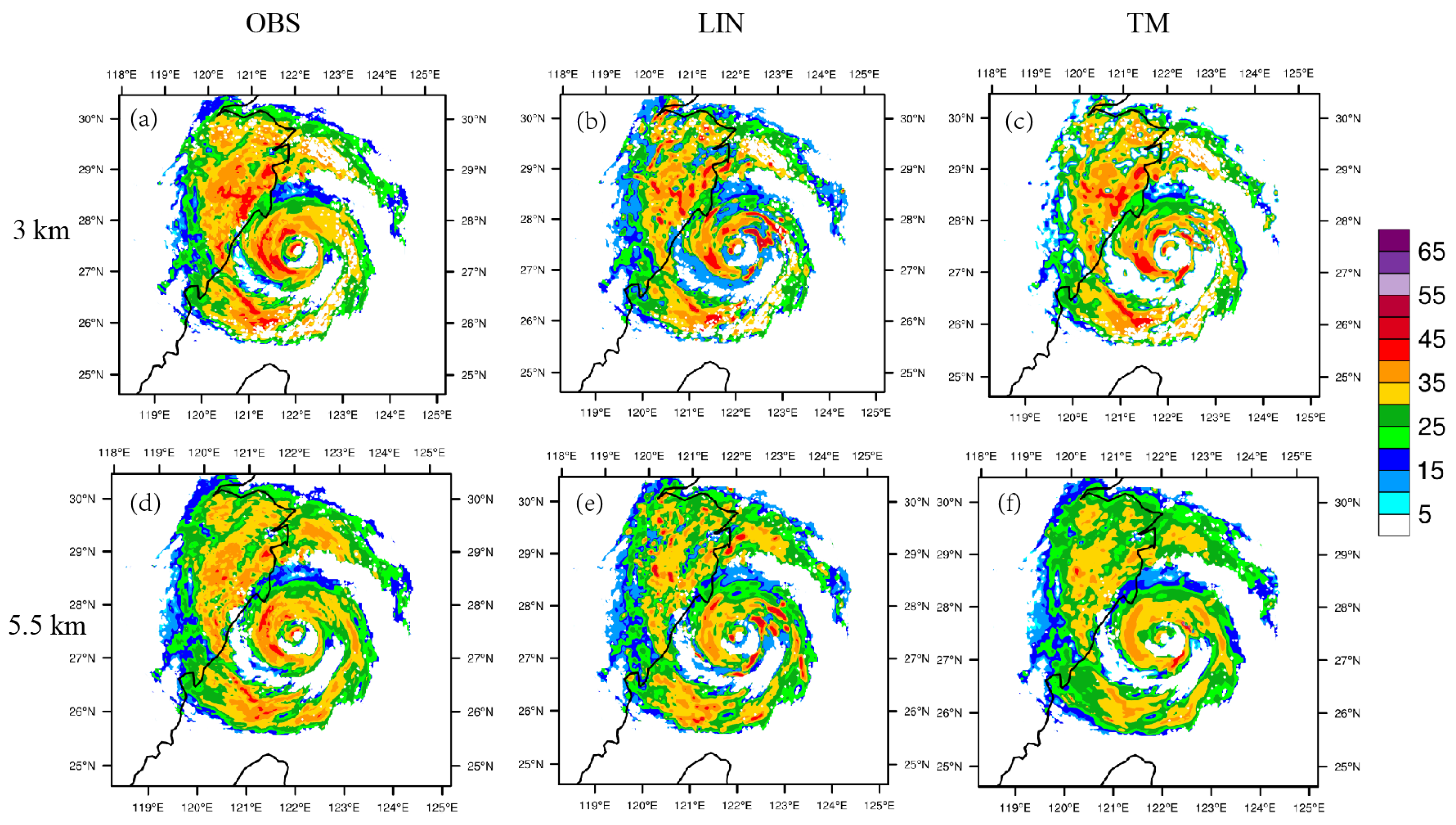

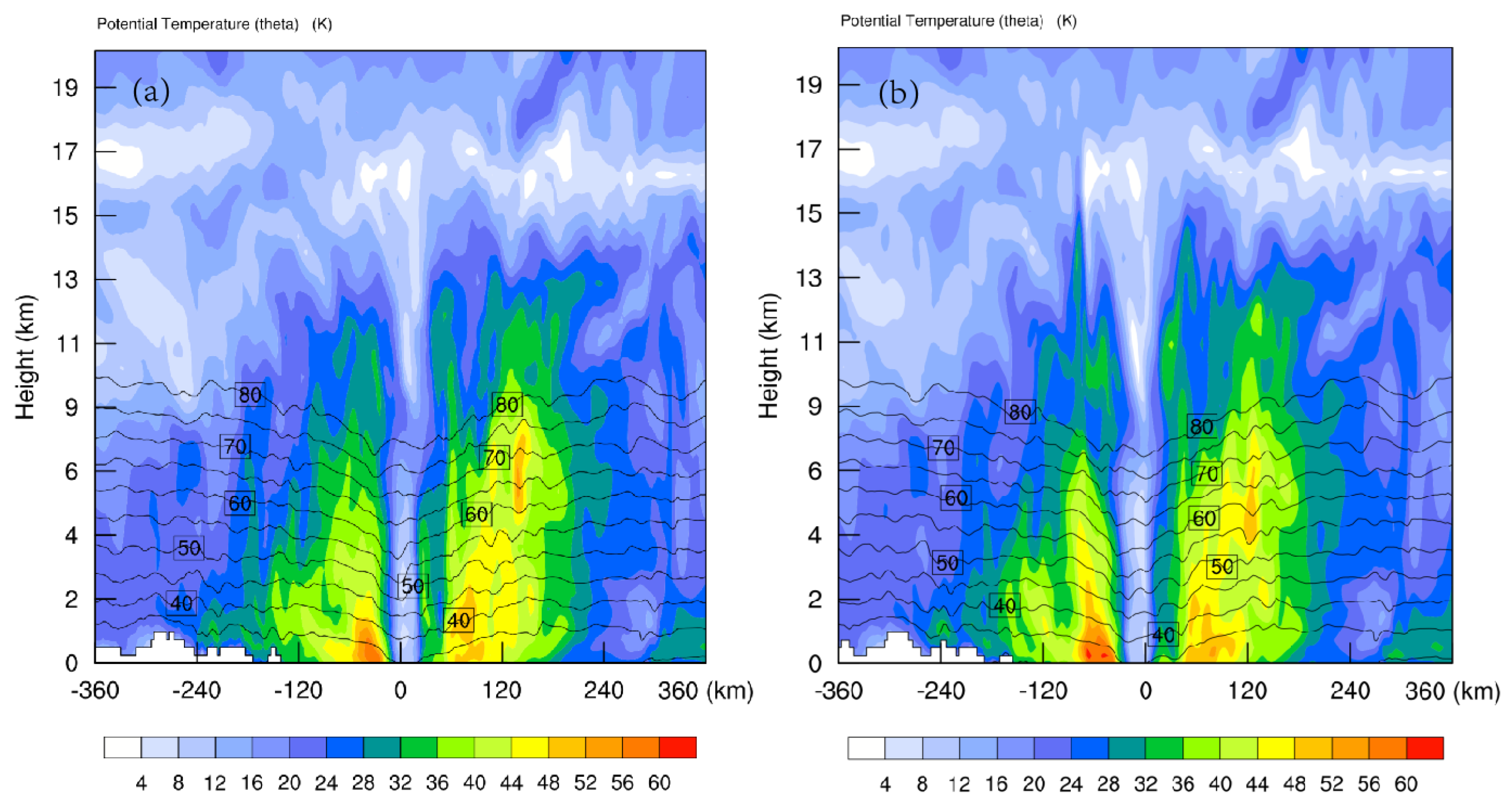
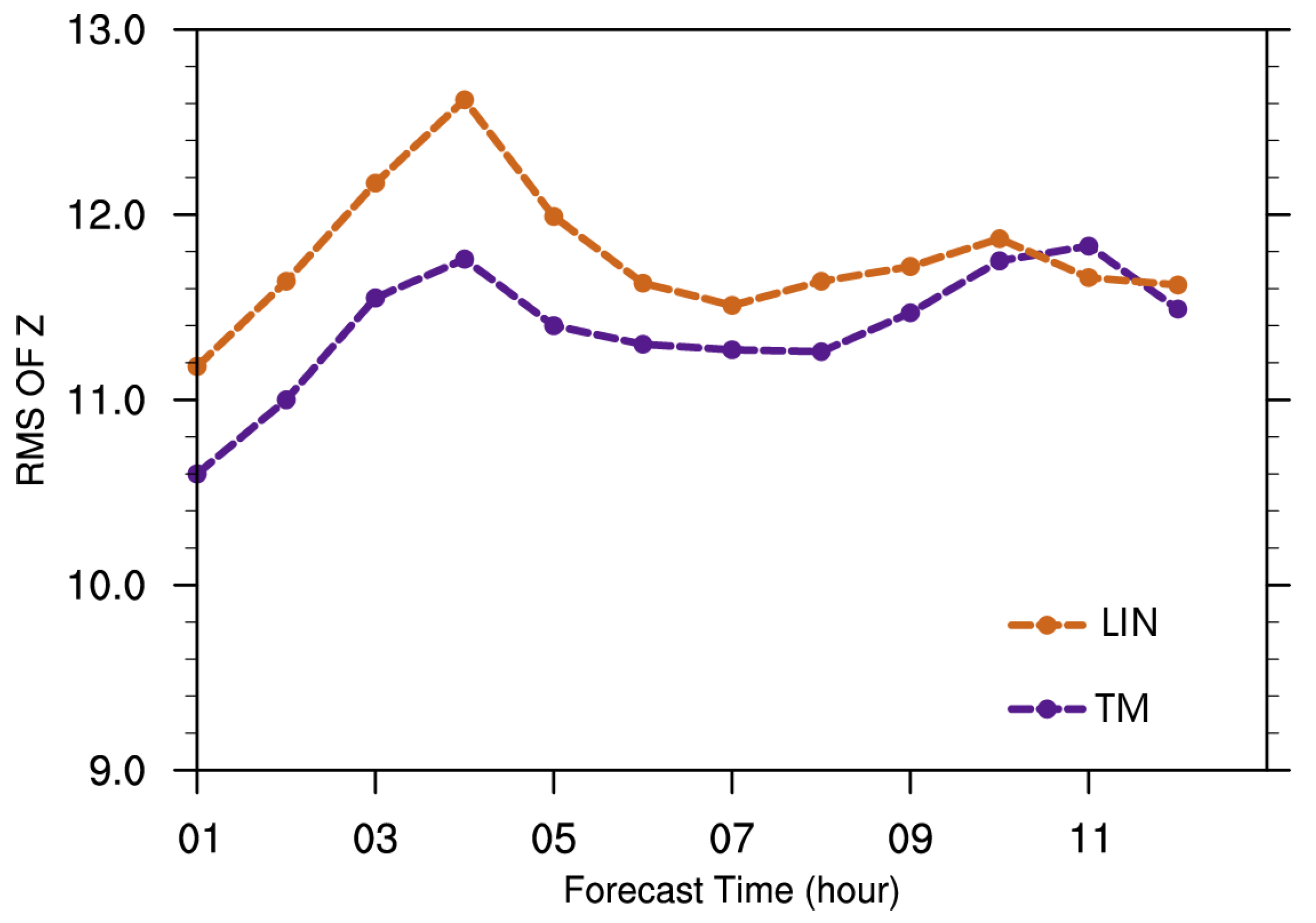
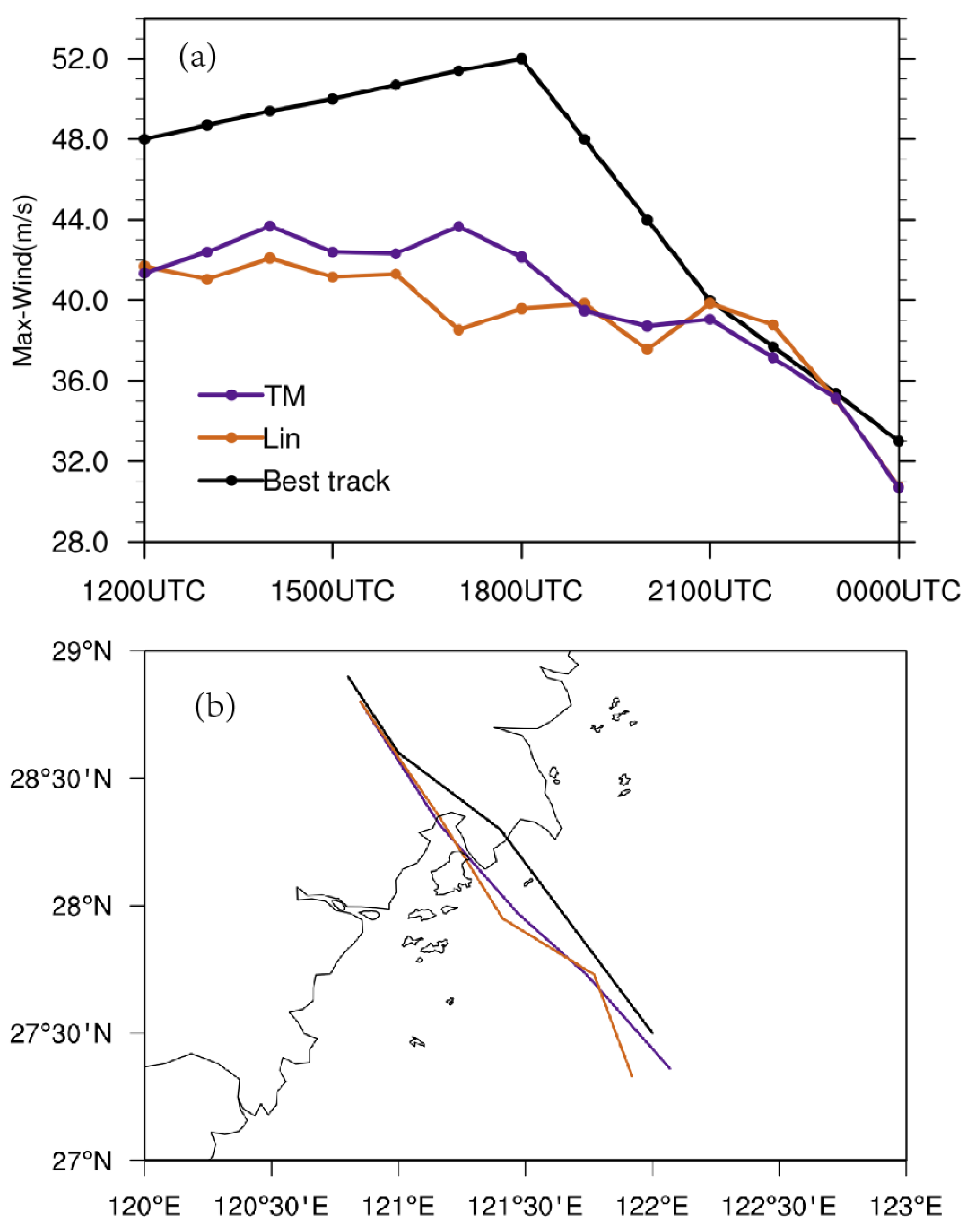

Disclaimer/Publisher’s Note: The statements, opinions and data contained in all publications are solely those of the individual author(s) and contributor(s) and not of MDPI and/or the editor(s). MDPI and/or the editor(s) disclaim responsibility for any injury to people or property resulting from any ideas, methods, instructions or products referred to in the content. |
© 2024 by the authors. Licensee MDPI, Basel, Switzerland. This article is an open access article distributed under the terms and conditions of the Creative Commons Attribution (CC BY) license (https://creativecommons.org/licenses/by/4.0/).
Share and Cite
Luo, J.; Li, H.; Zhu, Y.; Zhu, L. Impact of Directly Assimilating Radar Reflectivity Using a Reflectivity Operator Based on a Double-Moment Microphysics Scheme on the Analysis and Forecast of Typhoon Lekima (1909). Remote Sens. 2024, 16, 3918. https://doi.org/10.3390/rs16213918
Luo J, Li H, Zhu Y, Zhu L. Impact of Directly Assimilating Radar Reflectivity Using a Reflectivity Operator Based on a Double-Moment Microphysics Scheme on the Analysis and Forecast of Typhoon Lekima (1909). Remote Sensing. 2024; 16(21):3918. https://doi.org/10.3390/rs16213918
Chicago/Turabian StyleLuo, Jingyao, Hong Li, Yijie Zhu, and Lijian Zhu. 2024. "Impact of Directly Assimilating Radar Reflectivity Using a Reflectivity Operator Based on a Double-Moment Microphysics Scheme on the Analysis and Forecast of Typhoon Lekima (1909)" Remote Sensing 16, no. 21: 3918. https://doi.org/10.3390/rs16213918
APA StyleLuo, J., Li, H., Zhu, Y., & Zhu, L. (2024). Impact of Directly Assimilating Radar Reflectivity Using a Reflectivity Operator Based on a Double-Moment Microphysics Scheme on the Analysis and Forecast of Typhoon Lekima (1909). Remote Sensing, 16(21), 3918. https://doi.org/10.3390/rs16213918





